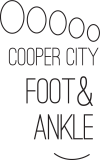Pigeon Toed (In-toeing)
Pigeon Toed (In-toeing) means that when a child walks or runs, the feet turn inward instead of pointing straight ahead. It is commonly referred to as being “pigeon-toed”.
Intoeing is often first noticed by parents when a baby begins walking, but children at various ages may display intoeing for different reasons.
Occasionally, severe intoeing may cause young children to stumble or trip as they catch their toes on the other heel. Intoeing usually does not cause pain, nor does it lead to arthritis.
In the vast majority of children younger than 8 years old, intoeing will almost always correct itself without the use of casts, braces, surgery, or any special treatment. A child whose intoeing is associated with pain, swelling, or a limp should be evaluated by an orthopaedic surgeon or podiatric surgeon.
Cause
The cause of intoeing depends on where the change in alignment is centered. There are three common conditions causing intoeing:
- Curved foot (metatarsus adductus)
- Twisted shin (tibia torsion)
- Twisted thighbone (femoral anteversion)
Each of these conditions may run in families. They also can simply occur on their own or in association with other orthopaedic problems. Prevention is not usually possible because they occur from developmental or genetic problems that cannot be controlled for.
Metatarsus Adductus
Metatarsus adductus is when a child’s feet bend inward from the middle part of the foot to the toes. Some cases may be mild and flexible, and others may be more obvious and rigid. Severe cases of metatarsus adductus may partially resemble a clubfoot deformity.
Metatarsus adductus improves by itself most of the time, usually over the first 4 to 6 months of life. Babies aged 6 to 9 months with severe deformity or feet that are very rigid may be treated with casts or special shoes with a high rate of success. Surgery to straighten the foot is seldom required.
Tibial Torsion
Tibial torsion occurs if the child’s lower leg (tibia) twists inward. This can occur before birth, as the legs rotate to fit in the confined space of the womb. After birth, an infant’s legs should gradually rotate to align properly. If the lower leg remains turned in, the result is tibial torsion.
When the child begins walking, the feet turn inward because the tibia in the lower leg, just above the foot, points the foot inward. As the tibia grows taller, it usually untwists.
Tibial torsion almost always improves without treatment, and usually before school age. Splints, special shoes, and exercise programs do not help. Surgery to re-set the bone may be done in a child who is at least 8 to 10 years old and has a severe twist that causes significant walking problems.
Femoral Anteversion
Femoral anteversion (also known as excessive femoral torsion) occurs when a child’s thighbone (femur) turns inward. It is often most obvious at about 5 or 6 years of age. The upper end of the thighbone, near the hip, has an increased twist, which allows the hip to turn inward more than it turns outward. This causes both the knees and the feet to point inward during walking. Children with this condition often sit in the ‘W” position, with their knees bent and their feet flared out behind them.
Femoral anteversion spontaneously corrects in almost all children as they grow older. Studies have found that special shoes, braces, and exercises do not help. Surgery is usually not considered unless the child is older than 9 or 10 years and has a severe deformity that causes tripping and an unsightly gait. Like surgery for tibial torsion, during the procedure for femoral anteversion, the femur is cut and rotated back into proper alignment.
